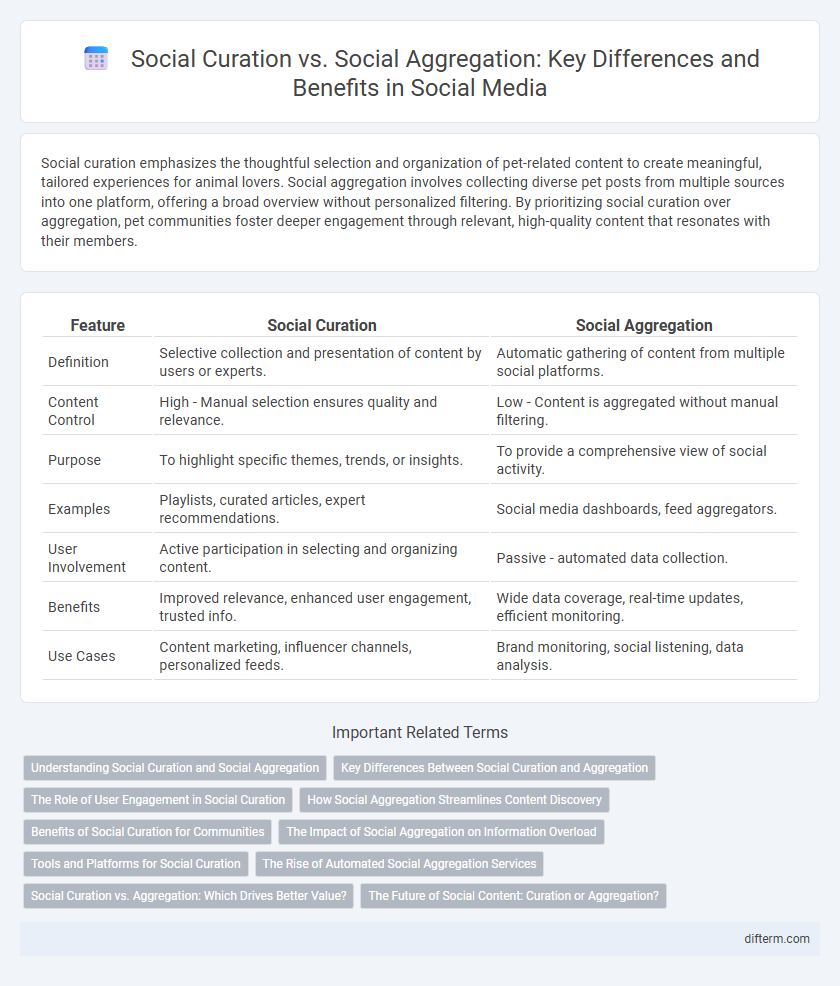Social curation emphasizes the thoughtful selection and organization of pet-related content to create meaningful, tailored experiences for animal lovers. Social aggregation involves collecting diverse pet posts from multiple sources into one platform, offering a broad overview without personalized filtering. By prioritizing social curation over aggregation, pet communities foster deeper engagement through relevant, high-quality content that resonates with their members.
Table of Comparison
| Feature | Social Curation | Social Aggregation |
|---|---|---|
| Definition | Selective collection and presentation of content by users or experts. | Automatic gathering of content from multiple social platforms. |
| Content Control | High - Manual selection ensures quality and relevance. | Low - Content is aggregated without manual filtering. |
| Purpose | To highlight specific themes, trends, or insights. | To provide a comprehensive view of social activity. |
| Examples | Playlists, curated articles, expert recommendations. | Social media dashboards, feed aggregators. |
| User Involvement | Active participation in selecting and organizing content. | Passive - automated data collection. |
| Benefits | Improved relevance, enhanced user engagement, trusted info. | Wide data coverage, real-time updates, efficient monitoring. |
| Use Cases | Content marketing, influencer channels, personalized feeds. | Brand monitoring, social listening, data analysis. |
Understanding Social Curation and Social Aggregation
Social curation involves individuals or communities actively selecting, organizing, and sharing content based on specific themes or interests, offering personalized and quality-driven material. Social aggregation automates the collection of diverse content from multiple sources into a single platform, enhancing convenience but often lacking editorial precision. Understanding the distinction helps users and marketers optimize content delivery by balancing relevance with comprehensive information access.
Key Differences Between Social Curation and Aggregation
Social curation involves the selective collection and presentation of content based on quality and relevance, often guided by human judgment and editorial insight. Social aggregation, in contrast, automatically gathers and organizes large volumes of data from various social media platforms, prioritizing quantity and real-time updates over curation. Key differences include the level of human intervention, the emphasis on content quality versus volume, and the purpose of engagement versus information consolidation.
The Role of User Engagement in Social Curation
User engagement drives social curation by enabling individuals to actively select, organize, and share content based on personal interests and community relevance, creating a more personalized and meaningful feed. Unlike social aggregation, which passively collects content from various sources, social curation leverages user interaction to enhance content quality and foster deeper connections within social networks. This participatory approach increases content diversity and authenticity, boosting overall user satisfaction and platform loyalty.
How Social Aggregation Streamlines Content Discovery
Social aggregation streamlines content discovery by collecting and organizing information from multiple social platforms into a single, easy-to-navigate feed. This method uses algorithms to filter and prioritize relevant content, enhancing user efficiency and engagement. By reducing the need to visit multiple sites, social aggregation ensures timely access to diverse perspectives and trending topics.
Benefits of Social Curation for Communities
Social curation enhances community engagement by fostering meaningful interactions and collective knowledge sharing, leading to a stronger sense of belonging. This approach emphasizes quality over quantity, allowing communities to access carefully selected, relevant content that resonates with their interests and values. By promoting thoughtful content discovery, social curation supports deeper connections and sustained participation within social platforms.
The Impact of Social Aggregation on Information Overload
Social aggregation consolidates vast amounts of user-generated content from multiple platforms, intensifying information overload by flooding users with excessive, often redundant data. Unlike social curation, which filters and organizes content to enhance relevance and usability, social aggregation risks overwhelming users with unstructured streams of information. This excess challenges users' ability to discern valuable insights, leading to decreased attention and engagement across social media environments.
Tools and Platforms for Social Curation
Social curation tools like Scoop.it, Flipboard, and Pocket enable users to discover, organize, and share content with personalized commentary, enhancing content relevance and engagement. Platforms such as Pinterest and Storify emphasize visual and narrative curation, allowing users to craft cohesive stories from diverse sources. Unlike social aggregation tools that collect content passively, social curation platforms prioritize user-driven selection and contextualization to create meaningful, tailored information experiences.
The Rise of Automated Social Aggregation Services
Automated social aggregation services have revolutionized content discovery by seamlessly compiling posts, articles, and media from diverse social platforms into a single stream, enhancing user experience through efficiency and breadth. Unlike social curation, which relies on human judgment to select and organize content for relevance and quality, automated aggregation leverages algorithms and AI to process large volumes of data rapidly, enabling real-time updates and personalized feeds. This rise in automation supports businesses and individuals in managing social media presence effectively, driving engagement by surfacing trending topics and insights without manual intervention.
Social Curation vs. Aggregation: Which Drives Better Value?
Social curation involves the selective organization and presentation of content by users who add context and personal insight, enhancing relevance and engagement, whereas social aggregation automatically collects content from various sources without editorial input. Studies show that social curation drives better value by fostering community trust and deeper user interaction, thereby increasing content quality and retention rates. Brands leveraging social curation benefit from higher conversion rates due to personalized experiences compared to the broader but less targeted reach of social aggregation.
The Future of Social Content: Curation or Aggregation?
Social curation emphasizes quality and relevance by handpicking content tailored to specific audiences, enhancing user engagement and trust. Social aggregation leverages algorithms to compile vast amounts of data from multiple sources, offering comprehensive and real-time updates. The future of social content hinges on hybrid models that combine curated expertise with automated aggregation to balance personalization and scalability.
social curation vs social aggregation Infographic

 difterm.com
difterm.com